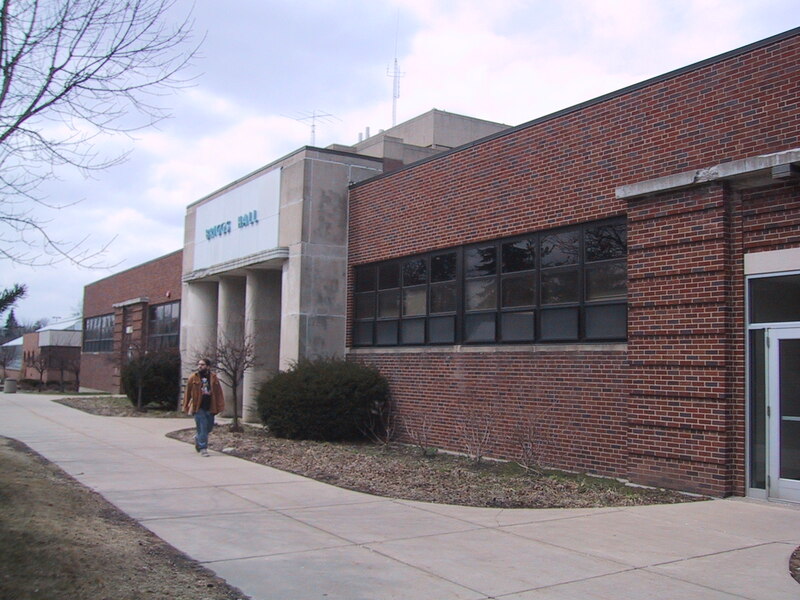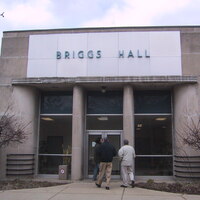-
Building Name
-
Briggs Hall
-
Description
-
President John Munson placed a gymnasium on his list of priority buildings for construction in the early 1930s. Munson found little support from the Michigan Legislature to fund such a project during the Depression. Munson turned to his personal friend and Ypsilanti native, Walter O. Briggs, Sr. for funding. Briggs, then owner of the Detroit Tigers, was deeply interested in physical education and willing to financially support the construction of the facility. The new field house, which opened in 1937, faced the back of McKenny Union at the heart of the social center of campus. Inside it contained lockers, showers, training rooms, and offices of officials. A large practice room with a dirt floor provided space for vaulting and other winter activities. It also acted as a gateway to Briggs Field which housed a 300 seat stand for football and another for baseball.
Today, Mark Jefferson Hall, Strong Hall, and the parking lot cover the athletic park. With the need for additional classroom space on campus in the early to mid 1960s, Briggs Hall was repurposed, initially for the Mathematics Department and then for the Art Department. Athletics were moved out of the center of campus with the construction of Rynearson Stadium in 1969 and the baseball Stadium in 1971.
-
Namesake Biography
-
Walter Owen Briggs, Sr. (February 27, 1877 - January 17, 1952) was an American entrepreneur and professional sports owner. He was part-owner of the Detroit Tigers in Major League Baseball from 1919 to 1935, and then sole owner from 1935 to his death in 1952. Briggs also helped found the Detroit Zoo in 1928, and personally paid for many of its first exhibits. He was also a patron of Eastern Michigan University and the Detroit Symphony Orchestra. Briggs was born in Ypsilanti, Michigan and grew up a Detroit Tigers fan. In his early youth he worked at the Michigan Central Railroad and later opened Briggs Manufacturing Company in 1908, which specialized in the manufacturing of automobile bodies for the auto industry and later diversified into plumbing fixtures. After the death of Tigers' part-owner Bill Yawkey in 1919, surviving partner Frank Navin arranged for Briggs to buy a 25 percent stake in the club. He later bought enough stock to become a full partner with Navin, though he stayed in the background while Navin was alive. After Navin died in 1935, Briggs became the sole owner of the franchise. Briggs was noted for fielding a well-paid team that won two American League pennants (1940, 1945) and a World Series championship in 1945 under his ownership. Briggs died at age 74 in Miami Beach, Florida in 1952. The franchise remained in the family until it was sold in 1956 to broadcast media owners John Fetzer and Fred Knorr.
-
Building Namesake
-
Walter O. Briggs, Owner of the Detroit Tigers, Ypsilanti native, and close friend to President Munso
-
Year Constructed
-
12-May-37
-
Date Dedicated
-
14-Oct-37
-
Building Functions
-
3-D Art Department annex for woodworking, metal, plastics, and jewelry
-
Briggs Fieldhouse, 1937 - 1956
-
Architect
-
Giffels and Vallet, Detroit, MI
-
Original Cost
-
66000
-
Architectural Style
-
Art Moderne
-
Square Footage
-
9500
-
Rights
-
This Item is protected by copyright and/or related rights. You are free to use this Item in any way that is permitted by the copyright and related rights legislation that applies to your use. In addition, no permission is required from the rights-holder(s) for educational uses. For other uses, you need to obtain permission from the owner, Eastern Michigan University Archives (lib_archives@emich.edu).





